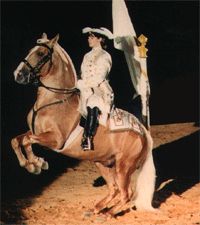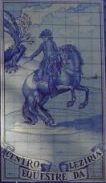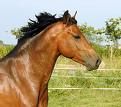Social Dinner
Lusitano Horse
Symposium Social Dinner on May 13th
 The Symposium Social Dinner will take place on Tuesday May 13th at the
"Lezíria Grande" Riding Center, located at about 25 km North of
Lisbon.
The Symposium Social Dinner will take place on Tuesday May 13th at the
"Lezíria Grande" Riding Center, located at about 25 km North of
Lisbon.
Buses will take the participants from Lisbon to "Leziria Grande". After arrival an aperitif will be served, followed by an equestrian show in the riding hall - were the stars will be Lusitanos horses - and then a seated dinner.
The trip back to LNEC and Campo Pequeno will be again by bus.
The departure from Lisbon to "Leziria Grande" will be around 6:00 pm (to be confirmed later on). It is expected to arrive at Lisbon at about 10:30 pm.
CENTRO EQUESTRE DA LEZÍRIA GRANDE
 The Lezíria Grande Riding Centre
was created and dedicated to the horse,
the riding school based on the work of the Marquis of Marialva and related activities.
The Lezíria Grande Riding Centre
was created and dedicated to the horse,
the riding school based on the work of the Marquis of Marialva and related activities. The location was built and planned combining the riding school with the natural beauty of the Leziria (name of the fertile plain through which the Tagus runs). The riding centre took its name from the floodplain, and the Lezíria Grande Riding Centre offers tourists the natural beauty of the setting, the horses, typical cuisine and the delicious local wines. The highlight of every entertainment is the Equestrian show, giving displays of High School where the potential of the Lusitano horse can be highlighted.
At the Riding Centre a number of different breeds of horses can be seen, however the Lusitano horse features most predominantly. The original characteristics of the Lusitano horse, which includes its great courage and obedience to the rider combined with agility and a unique ability to go down on the haunches and remain in balance, all of which makes it invaluable in bull fighting, have been preserved here.
The traditions and costumes of the 18c are to be seen here, and this includes the harness and above all the horsemanship practiced at that time, the golden age of the art of riding.
Through the efforts of a few individuals this horsemanship and tradition has survived, and influenced the way of riding in Portugal. This represents a very special and unusual equestrian heritage in terms of the teaching of the art of riding, which has such a brilliant reputation in Portugal.
For more information visit http://www.celg.pt
Driving directions from Lisbon
By car, follow A1 high-way (direction Oporto) and take the exit "Vila Franca de Xira" at km 25. After the toll booths, bear right toward “Carregado” (road N1). After 500m you will then see, on the left, a blue sign that says "Leziria Grande". This access is 200m after a “Repsol” gas station that stands on the right of the road.
Click here to go to "coordinates and map" page .
 The Lusitano is an ancient Portuguese breed of horse that until the 1960s shared its
registration with the Spanish horse, the Andalusian. Both are sometimes called Iberian horses,
as their land of origin is the Iberian Peninsula. These Iberian horses were developed for use in war, dressage and bull fighting.
In the 17th century the Spanish ceased fighting bulls from horseback and at that time began
to selectively breed horses for saddle and parade use: flashy gaits, strong bones and powerful presence.
The Portuguese continue to fight the bull from horseback and have sought to keep the historic characteristics of the Lusitano intact.
These characteristics include great bravery, with a tendency to move forward into that which threatens,
calmness, with great fire while under saddle. Most importantly, the Lusitano often has a subconvex profile, (Roman nose,)
a trait that has been found to be tied genetically with an aptitude for "La Gineta,"
the ancient equestrian art defined by the necessities of mounted single combat or its contemporary replacements:
bull fighting, dressage, jumping. Lusitanos make excellent riding horses due to their level headed temperament and
tendency to bond strongly with humans. They are intelligent, sensible, and have great balance.
The Lusitano is an ancient Portuguese breed of horse that until the 1960s shared its
registration with the Spanish horse, the Andalusian. Both are sometimes called Iberian horses,
as their land of origin is the Iberian Peninsula. These Iberian horses were developed for use in war, dressage and bull fighting.
In the 17th century the Spanish ceased fighting bulls from horseback and at that time began
to selectively breed horses for saddle and parade use: flashy gaits, strong bones and powerful presence.
The Portuguese continue to fight the bull from horseback and have sought to keep the historic characteristics of the Lusitano intact.
These characteristics include great bravery, with a tendency to move forward into that which threatens,
calmness, with great fire while under saddle. Most importantly, the Lusitano often has a subconvex profile, (Roman nose,)
a trait that has been found to be tied genetically with an aptitude for "La Gineta,"
the ancient equestrian art defined by the necessities of mounted single combat or its contemporary replacements:
bull fighting, dressage, jumping. Lusitanos make excellent riding horses due to their level headed temperament and
tendency to bond strongly with humans. They are intelligent, sensible, and have great balance.
The Lusitano derives its name from Lusitania, the name which the ancient Romans gave to the part of the Iberian Peninsula that corresponds roughly to modern Portugal and also a part of modern Spain.
From wikipedia.org